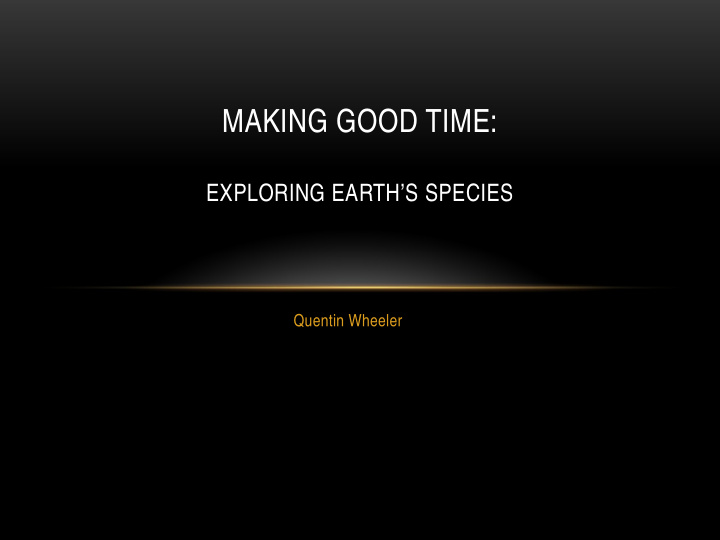



MAKING GOOD TIME: EXPLORING EARTH’S SPECIES Quentin Wheeler
ORIGINS: THE EVOLUTIONARY CONTINUUM
“How many species of organisms are there on Earth? We do not know, not even to the nearest order of magnitude.” — E. O. Wilson, 1985
SOURCE: I.N. SARKAR, R. SCHENK & C. NORTON (2008)
SOURCE: NCBI GENBANK STATISTICS (1982-2008)
DOUBLING TIME • Sum Human Knowledge 2 years • GenBank 1.5 years • Species 114 years
Argument
1940s experimental pop gen superior • Taxonomy seen as service today • Species often seen as arbitrary • If these were true, any data as good as any other •
DNA-BASED TAXONOMY: SERVICES Species IDs • Phylogeny •
DNA barcodes and species identifications statelyplumpbuckmulligancamefromthestairheadbearingabowloflatheron whichamirrorandarazorlaycrossedayellowdressinggownungirdledwassus tainedgentlybehindhimbythemildmorningairheheldthebowlaloftandintoned introiboadaltaredeihaltedhepeereddownthedarkwindingstairsandcalledup coarselycomeupkinchcomeupyoufearfuljesuitsolemnlyhecameforwardand mountedtheroundgunresthefacedaboutandblessedgravelythricethetow erthesurroundingcountryandtheawakingmountainsthencatchingsightofste phendedalushebenttowardshimandmaderapidcrossesintheairgurglinginhis throatandshakinghisheadstephendedalusdispleasedandsleepyleanedhisarm sonthetopofthestaircaeandlookedcoldlyattheshakinggug hereisedwardbearcomingdownstairsnowbumpbumpbumponthebackofhis headbehindchristopherrobinitisasfarasheknowstheonlywayofcomingdown stairsbutsomegtimeshefeelsthatthererealyisanotherwayifonlyhecouldstop bumpingforamomentandthinkofitandthenhefeelsthatperhapsthereisntany howhereheisatthebottomandreadytobeintroducedtoyouwinniethepoohwheni firstheardhisnameisaidjustasyouaregoingtosaybutithougthhewasaboysodidi saidchristopherrobinthenyoucantcallhimwinnieidontbutyousaidheswin netherpoohdontyouknowwhatthermeansahyesnowidoisaidquicklyandihopey oudotoobecauseitisalltheexplanationyouaregoingtogetsometimeswinniethe poohlikesagameofsomesortwhenhecomesdownstairsandsom
Phylogenetic relationships among species
What would it take to describe 10,000,000 additional species in 50 years or less? 1 order of magnitude acceleration of annual rate of description to 200,000 spp/yr
Decadal Survey of Astronomy and Astrophysics, 2012-2021 Ground Large ($4.21 billion) Ground Medium ($37 million) Ground Small ($270 million) Space Large ($3.1 billion) Space Medium ($400 million) Space Small ($415 million) Source: Nature , 19 August 2010. Total=$8.4B Same period. NSF= $7.3B. DEB=$1.3B.
We have allowed taxonomy to be define narrowly when it is in fact by nature multifaceted and trans-disciplinary Infrastructure Taxonomy Morphology Collections (traditional) Ontogeny Collections (DNA, recordings, etc.) Paleontology DNA Cyber-infrastructure Nomenclature Classification Commons Monography Access to research resources Geography Phylogenetics
MORPHOLOGY IS END, NOT (OUTDATED) MEANS
DUALITY OF TAXONOMY • Inventory, describe, name, and phylogenetically classify millions of species that are results and record of evolutionary history • Explore and understand sequence and history of character transformations from common ancestral single-celled species to billions of derived characters seen among living species
A FEW ADDITIONAL REASONS TO DESCRIBE MORPHOLOGY
RECOGNIZE OBJECTS OF NATURAL SELECTION
DIRECT COMPARISON WITH FOSSIL SPECIES TRACK DEVELOPMENTAL SEQUENCE (ONTOGENY)
MINE ADAPTATIONS FOR BIOMIMICRY
EYEBALL ENTOMOLOGY
COSMOLOGY: EXPLORE & DESCRIBE KINDS OF OBJECTS AND THEIR PROPERTIES IN UNIVERSE, UNDERSTAND THEIR ORIGINS AND HISTORIES
TAXONOMY: EXPLORE & DESCRIBE KINDS OF LIVING THINGS IN BIOSPHERE AND THEIR PROPERTIES, UNDERSTAND THEIR ORIGINS AND HISTORIES Reconstruct Phylogeny and History of Character Transformations Ancestral “Eve” Species 12 Million Eukaryotic Species + Billions and Billions of Apomorphies Life’s “Big Bang” and 3.8 Billion Year Expanding Universe of Biological Diversity
Recommend
More recommend